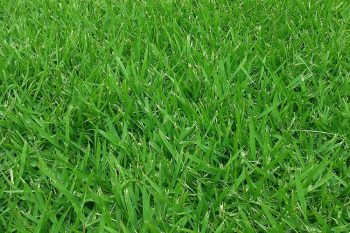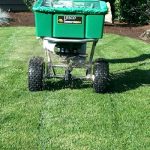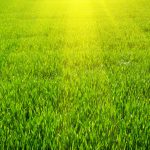 North Texas lawns need grass that can tolerate a wide range of conditions. From sweltering heat to winter freezes, from springtime downpours to lengthy droughts. With this versatility in our area’s temperatures, terrains, and precipitation, a few grass breeds have risen to the top as favorites due to their resilience.
North Texas lawns need grass that can tolerate a wide range of conditions. From sweltering heat to winter freezes, from springtime downpours to lengthy droughts. With this versatility in our area’s temperatures, terrains, and precipitation, a few grass breeds have risen to the top as favorites due to their resilience.
Bermuda grass, Zoysia grass, and St. Augustine are the three most common grass types in North Texas. Let’s take a look at the best practices in lawn care for these popular turfs.
A Good Watering Schedule
Due to frequent Texas droughts, most homeowners have grown accustomed to restrictive watering schedules. Many would say one should water their grass at least 3 times per week, but that way of thinking isn’t really accurate to what your grass needs. Did you know that 1 inch per week is actually adequate for most lawns?
Watering deeply- which means watering for a longer period of time- lets your topsoil to soak in and store extra water. This not only allows you to water less frequently, it also protects your soil from drying out in excessive heat. So how do our 3 top breeds fare when it comes to reduced irrigation?
St. Augustine is certainly drought tolerant, but it needs a bit more hydration than the other two. Zoysia grass can go the longest with the least amount of water, and Bermuda grass is somewhere in the middle. Whichever ground cover you’ve got, the good news is you probably don’t need to water it as frequently as you thought.
Successful Weed Control
When it comes to weeds, images of dandelions and crabgrass often come to mind. However, a weed is any sort of opportunistic, rapidly spreading plant that can take over your landscape. Manual weed removal is a tried-and-true method of spot treatment, but be sure you pull up the entire root.
For chemical weed treatment, here’s more information on choosing an effective herbicide.
One of the best things you can do for preventative weed control is keeping your grass healthy. A dense, robust ground cover is less vulnerable to intruders, because there just isn’t room for them to germinate. All 3 of our top Texas breeds are favorably dense growers, but the tough, thick runners found in Bermuda grass make it extra weed-resistant.
Adequate Fertilization
Speaking of feeding your lawn, let’s take a look at fertilization practices. When it comes to this feeding your grass, it’s important to consider both the timing and the products you choose.
While it’s important to fertilize several times per year, you want to be sure to do so before it gets too hot in the summertime. Even all-natural fertilizers contain chemical compounds that can burn your lawn if they’re applied during extreme heat. Try to be sure you’ve treated your lawn with an application before the end of May, or before your local temperatures begin to regularly exceed 90*F.
 The fertilizers used most commonly in our region will typically have a mix of nitrogen, phosphorous, and potassium. The ratios of these 3 compounds are generally easy to spot on the product’s container. Most North Texas grasses need a healthy dose of nitrogen, but it varies from one species to the next.
The fertilizers used most commonly in our region will typically have a mix of nitrogen, phosphorous, and potassium. The ratios of these 3 compounds are generally easy to spot on the product’s container. Most North Texas grasses need a healthy dose of nitrogen, but it varies from one species to the next.
Bermuda grass needs a nitrogen-rich fertilizer, while Zoysia requires far less. St. Augustine, as well as many other breeds, tend to fall somewhere in the middle. Depending on what you’re feeding, a mix of slow-release and instant-release nitrogen may be the way to go.
Aerate and Dethatch When Necessary
Another important component of keeping your grass healthy is making sure the topsoil can breathe. Both aerating and dethatching are important parts of this process, but luckily they don’t need to be done regularly. Aerating is typically done once per year, while dethatching is only addressed when necessary.
For Texas grasses, aerating is best performed in the spring or summer, and there are liquid aeration products to make the job easier. This practice enhances air exchange in your soil, and it increases the absorption of water and fertilizer. An aerated lawn has well-hydrated roots and is less vulnerable to nutrient deficiencies.
Both Bermuda grass and Zoysia grass produce enough thatch to need occasional detatching, while St. Augustine is somewhat less dense. If your lawn’s undergrowth is too thick, this can- once again- prevent water absorption, leaving your grass vulnerable to fungal disease from moisture buildup. Effectively dethatching your lawn requires special equipment, so be sure you [request a lawn care consultation] if you’re needing help with this task.
Lawn Mowing Tips
All 3 of the grass types we’re discussing grow fairly heartily in this region. While some would assume that the mowing height and schedule for different grasses is relatively uniform, there are actually a few details you may not have considered.
Did you know that leaving your blades longer, even up to 3 inches high, can help prevent your topsoil from drying out during a drought? This practice also makes for a softer, cushioned carpet for bare feet and playing children. If you want to reduce your mowing schedule and protect your turf during a dry season, consider keeping your grass a bit taller.
On the other hand, some breeds such as Bermuda grass tend to benefit from a shorter cut. Mowing as low as 1 inch can get hazardous with a standard mower. If this is the ground cover you’ve chosen for your lawn and you want to try a closer trim, try using an old-fashioned reel mower to get the job done. If you’re in the market for a new machine, be sure to take a look at Best Lawn Mowers Under $300.
Considering Shade Cover
Of all the topics we’re exploring, shade cover may have the most variation between our 3 Texas grass breeds. This can be a major deciding factor when it comes to choosing which type to lay on a new lawn. If you’re in the market for a new ground cover, you want to monitor the amount of shade cover each part of your yard is getting throughout the day.
How close are the homes surrounding your own, and how much of a shadow are they casting onto your front and back yards? How mature are the trees on your lawn, and how dense is the foliage? Do they provide full shade or is it dappled? These things directly influence the ratio of sun vs. shade exposure your lawn receives.
For a thoroughly shaded yard, St. Augustine is your best bet. It requires the least amount of sunlight in order to thrive. Bermuda grass, on the other hand, needs as much sun exposure as possible to remain healthy. For partial or dappled shade, Zoysia grass provides a happy medium because it enjoys moderate amounts of sunlight. Survey your landscape and make the best choice about which grass breed is most likely to thrive.
 Conclusion
Conclusion
There’s more to a healthy lawn than just mowing and running the sprinkler system. But you can maintain a beautiful yard by utilizing your knowledge of these 6 components to effective lawn care. Whether you’ve chosen Bermuda grass, St. Augustine, or Zoysia grass as your home’s ground cover, you can achieve the results you want for a landscape worth bragging about.
